#hardware design
Explore tagged Tumblr posts
Text

Steve Jobs, Apple's co-founder, didn’t contribute to programming or hardware design. Steve Wozniak, the technical mind behind Apple’s early products, and other employees recognized Wozniak as the inventor and Jobs as the marketing strategist.
#Steve Jobs#Steve Wozniak#Apple#programming#hardware design#marketing#invention#technology history#computer science#entrepreneurship#Brands
106 notes
·
View notes
Text
#Marathon#Cinematic Short#2025#Alberto Mielgo#Bungie#team-based extraction shooter#Runner#character design#character art#art#design#color#style#tech#hardware#tech design#hardware design#scifi#science fiction#future tech#future wear#tech wear#video
76 notes
·
View notes
Text
Hell is terms like ASIC, FPGA, and PPU
I haven't been doing any public updates on this for a bit, but I am still working on this bizarre rabbit hole quest of designing my own (probably) 16-bit game console. The controller is maybe done now, on a design level. Like I have parts for everything sourced and a layout for the internal PCB. I don't have a fully tested working prototype yet because I am in the middle of a huge financial crisis and don't have the cash laying around to send out to have boards printed and start rapidly iterating design on the 3D printed bits (housing the scroll wheel is going to be a little tricky). I should really spend my creative energy focusing on software development for a nice little demo ROM (or like, short term projects to earn money I desperately need) but my brain's kinda stuck in circuitry gear so I'm thinking more about what's going into the actual console itself. This may get techie.
So... in the broadest sense, and I think I've mentioned this before, I want to make this a 16-bit system (which is a term with a pretty murky definition), maybe 32-bit? And since I'm going to all this trouble I want to give my project here a little something extra the consoles from that era didn't have. And at the same time, I'd like to be able to act as a bridge for the sort of weirdos who are currently actively making new games for those systems to start working on this, on a level of "if you would do this on this console with this code, here's how you would do it on mine." This makes for a hell of a lot of research on my end, but trust me, it gets worse!
So let's talk about the main strengths of the 2D game consoles everyone knows and loves. Oh and just now while looking for some visual aids maybe I stumbled across this site, which is actually great as a sort of mid-level overview of all this stuff. Short version though-
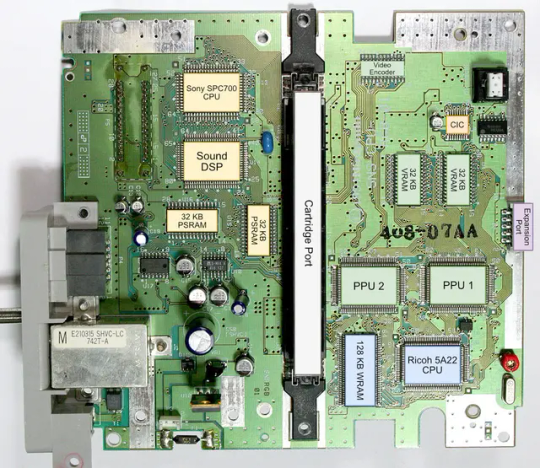
The SNES (or Super Famicom) does what it does by way of a combination of really going all in on direct memory access, and particularly having a dedicated setup for doing so between scanlines, coupled with a bunch of dedicated graphical modes specialized for different use cases, and you know, that you can switch between partway through drawing a screen. And of course the feature everyone knows and loves where you can have one polygon and do all sorts of fun things with it.
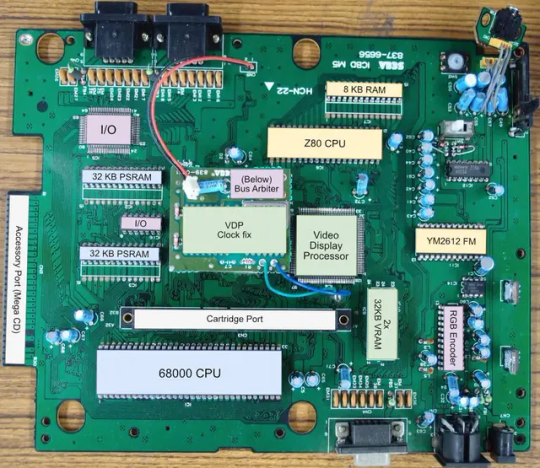
The Genesis (or Megadrive) has an actual proper 16-bit processor instead of this weird upgraded 6502 like the SNES had for a scrapped backwards compatibility plan. It also had this frankly wacky design where they just kinda took the guts out of a Sega Master System and had them off to the side as a segregated system whose only real job is managing the sound chip, one of those good good Yamaha synths with that real distinct sound... oh and they also actually did have a backwards compatibility deal that just kinda used the audio side to emulate an SMS, basically.
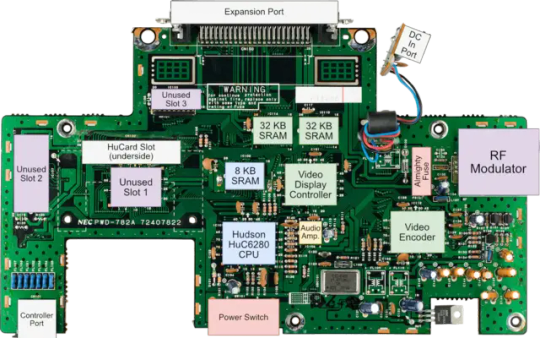
The TurboGrafix-16 (or PC Engine) really just kinda went all-in on making its own custom CPU from scratch which...we'll get to that, and otherwise uh... it had some interesting stuff going on sound wise? I feel like the main thing it had going was getting in on CDs early but I'm not messing with optical drives and they're no longer a really great storage option anyway.
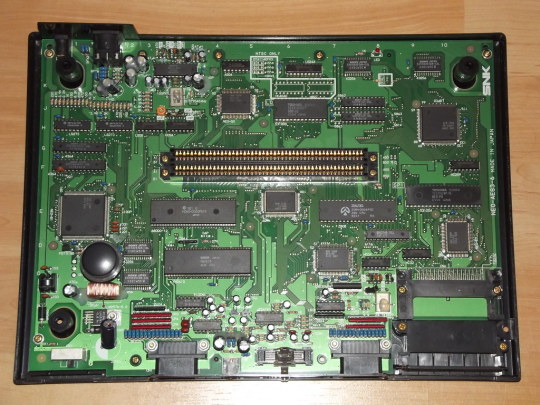
Then there's the Neo Geo... where what's going on under the good is just kind of A LOT. I don't have the same handy analysis ready to go on this one, but my understanding is it didn't really go in for a lot of nice streamlining tricks and just kinda powered through. Like it has no separation of background layers and sprites. It's just all sprites. Shove those raw numbers.
So what's the best of all worlds option here? I'd like to go with one of them nice speedy Motorolla processors. The 68000 the Genesis used is no longer manufactured though. The closest still-in-production equivalent would be the 68SEC000 family. Seems like they go for about $15 a pop, have a full 32-bit bus, low voltage, some support clock speeds like... three times what the Genesis did. It's overkill, but should remove any concerns I have about having a way higher resolution than the systems I'm jumping off from. I can also easily throw in some beefy RAM chips where I need.
I was also planning to just directly replicate the Genesis sound setup, weird as it is, but hit the slight hiccup that the Z80 was JUST discontinued, like a month or two ago. Pretty sure someone already has a clone of it, might use that.
Here's where everything comes to a screeching halt though. While the makers of all these systems were making contracts for custom processors to add a couple extra features in that I should be able to work around by just using newer descendant chips that have that built in, there really just is no off the shelf PPU that I'm aware of. EVERYONE back in the day had some custom ASIC (application-specific integrated circuit) chip made to assemble every frame of video before throwing it at the TV. Especially the SNES, with all its modes changing the logic there and the HDMA getting all up in those mode 7 effects. Which are again, something I definitely want to replicate here.
So one option here is... I design and order my own ASIC chips. I can probably just fit the entire system in one even? This however comes with two big problems. It's pricy. Real pricy. Don't think it's really practical if I'm not ordering in bulk and this is a project I assume has a really niche audience. Also, I mean, if I'm custom ordering a chip, I can't really rationalize having stuff I could cram in there for free sitting outside as separate costly chips, and hell, if it's all gonna be in one package I'm no longer making this an educational electronics kit/console, so I may as well just emulate the whole thing on like a raspberry pi for a tenth of the cost or something.
The other option is... I commit to even more work, and find a way to reverse engineer all the functionality I want out with some big array of custom ROMs and placeholder RAM and just kinda have my own multi-chip homebrew co-processors? Still PROBABLY cheaper than the ASIC solution and I guess not really making more research work for myself. It's just going to make for a bigger/more crowded motherboard or something.
Oh and I'm now looking at a 5V processor and making controllers compatible with a 10V system so I need to double check that all the components in those don't really care that much and maybe adjust things.
And then there's also FPGAs (field programmable gate arrays). Even more expensive than an ASIC, but the advantage is it's sort of a chip emulator and you can reflash it with something else. So if you're specifically in the MiSTer scene, I just host a file somewhere and you make the one you already have pretend to be this system. So... good news for those people but I still need to actually build something here.
So... yeah that's where all this stands right now. I admit I'm in way way over my head, but I should get somewhere eventually?
11 notes
·
View notes
Text
#hardware design#hardware design services#pcb assembly#pcb design#pcb manufacturer#pcba#pcbassembly#electronics design#automotive electronics
2 notes
·
View notes
Text
Understanding Hardware Design
As technology becomes more and more complex there is an ever growing need to understand and implement reliable and cost-effective hardware – all to support software expectations. Just a decade earlier it was common for a Hardware Engineer to also be a Software Engineer – and this is still the case of many simple products or when developing hobby level electronics. In this article we’ll go through the method of developing hardware as well as some tips and tricks to ease your development.
0 notes
Text
Turn key model
Unconventional Approaches in Embedded Hardware Design: What’s Really Changing?

The field of embedded hardware design has long been seen as highly specialized, with a focus on optimizing performance, reducing power consumption, and ensuring reliability. Traditionally, engineers followed well-established patterns, adhering to industry standards for board layout, component selection, and interfacing with software. However, in recent years, unconventional approaches are emerging, driven by new technology requirements and the need for more efficient, scalable, and adaptive systems. These shifts are not only reshaping the way we think about embedded systems but also pushing embedded hardware design companies to rethink their development strategies.
Rethinking Form Factors and Materials
One of the key areas where embedded hardware is evolving is in its physical form. Conventional designs have often been constrained by the standard dimensions of printed circuit boards (PCBs) and the limitations of traditional materials. However, advances in flexible and stretchable electronics are enabling entirely new possibilities for embedded hardware design projects.
These developments involve materials such as flexible substrates, which allow circuits to bend, twist, or fold without breaking. This can be crucial for applications in wearables, medical devices, and even certain aerospace technologies, where space and adaptability are critical. With these new form factors, embedded hardware becomes more versatile, accommodating designs that fit seamlessly into the human body, vehicles, or cramped industrial environments.
For embedded hardware design services, this shift means thinking beyond the rigidity of conventional components and adapting to a world where hardware needs to conform to increasingly demanding applications.
Open Hardware Platforms: A New Path Forward
Another significant trend shaping the embedded hardware design & development process is the adoption of open-source hardware platforms. While software development has seen a surge in open-source projects, hardware has been slower to embrace this trend. However, the growing interest in platforms like Arduino, Raspberry Pi, and BeagleBone is changing that landscape.
Open hardware platforms provide pre-designed, modular systems that can be customized for specific applications. This shift is lowering the barrier to entry for startups and smaller embedded hardware design companies, which may not have the resources to develop systems from scratch. By using open hardware, developers can quickly prototype ideas, reducing time to market while ensuring flexibility.

AI and Machine Learning at the Hardware Level
Artificial intelligence (AI) and machine learning (ML) are usually discussed in the context of software, but they are starting to play a role in embedded system hardware design as well. Traditionally, embedded systems relied on predefined algorithms for data processing. But with the integration of AI, hardware is becoming more adaptive, capable of adjusting itself in real-time based on environmental conditions or operational feedback.
Edge computing is a perfect example of where this trend is having a significant impact. Instead of sending all data to the cloud for processing, embedded systems can now handle complex AI tasks locally, thanks to more intelligent hardware architectures. These architectures are optimized to run AI models efficiently, without the need for heavy computational resources.

Power Efficiency Through Energy Harvesting
Embedded systems have always been designed with power efficiency in mind, particularly for applications where changing batteries frequently isn’t practical, such as remote sensing, medical implants, or IoT devices. Traditional power optimization strategies focus on minimizing energy consumption through low-power states or more efficient algorithms.
However, energy harvesting is emerging as a game-changer for embedded hardware design. By capturing energy from ambient sources like light, heat, or motion, devices can potentially operate indefinitely without external power sources. This capability drastically reduces maintenance costs and extends the operational life of embedded systems in remote or inaccessible locations.
Energy harvesting technology is still evolving, but it holds great promise. As more embedded hardware design companies integrate this technology into their designs, it could fundamentally change the way we think about powering devices in the future.
The Rise of Custom Silicon
Custom silicon, particularly application-specific integrated circuits (ASICs), is gaining traction in the embedded hardware design & development world. Instead of relying on general-purpose processors or microcontrollers, more companies are designing custom chips tailored to their specific needs. This approach allows for greater optimization, both in terms of performance and power efficiency, as the chip is designed precisely for the intended use case.
This trend is particularly evident in high-performance applications such as cryptocurrency mining, AI acceleration, and telecommunications, where standard off-the-shelf components can’t deliver the required performance. Custom silicon can also improve security, as companies can integrate hardware-level protections directly into the chip.
Cross-Disciplinary Collaboration
As embedded systems become more complex, embedded hardware design projects are increasingly benefiting from collaboration across multiple disciplines. Mechanical engineers, material scientists, software developers, and electrical engineers are working together more closely than ever before. This interdisciplinary approach allows teams to tackle problems holistically, considering all aspects of the system, from the physical constraints of the hardware to the software that drives it.
Cross-disciplinary collaboration also opens the door to more innovative solutions, as professionals from different fields bring unique perspectives and expertise to the table. This trend will continue to drive forward the capabilities of embedded hardware design, enabling more sophisticated and integrated systems.
Conclusion,
The embedded hardware design industry is undergoing a transformation as new materials, open platforms, AI integration, energy harvesting, custom silicon, and cross-disciplinary collaboration reshape the field. These unconventional approaches are pushing the boundaries of what embedded systems can achieve, offering more efficiency, adaptability, and intelligence. For companies involved in embedded hardware design services, staying ahead means embracing these changes and rethinking traditional approaches to meet the demands of future applications.
For more information on embedded product design companies in usa subscribe to our blog. For sales queries, contact us at +1 (775) 404-5757 or email [email protected]. We are here to assist you.
0 notes
Text
Enhancing Battery Life in IoT Smart Camera Hardware Design
In IoT smart home security camera designs, wireless connectivity consumes a significant portion of the power budget. Discover how to manage power efficiently as smart cameras incorporate more processing capabilities.
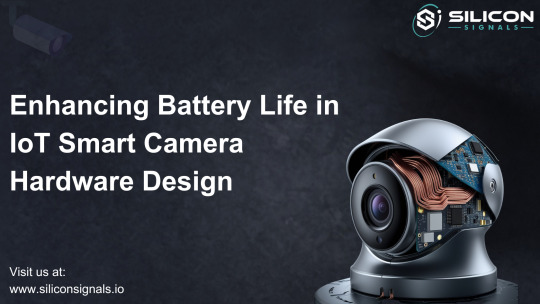
According to a recent report by Global Market Insights, the smart home security camera market is expected to see significant growth from 2023 to 2032, fueled by a sharp increase in residential criminal activities around the globe.
The U.S. Department of Justice estimates there are approximately 2.5 million burglaries annually. Homeowners are using technology to fight back. IoT adoption in smart homes, such as through easy-to-install video cameras, is boosting detection capabilities and enhancing overall security.
Since these solutions are optimized at the system level, developers of smart IoT video cameras are increasingly integrating machine learning (ML) and artificial intelligence (AI) to address the rapidly expanding security needs. However, there are still some basic challenges for video cameras — and they involve powering devices with batteries that just don’t meet the challenge.
Inherent Challenges With Video Cameras
Today’s top-selling battery-based Wi-Fi smart cameras use batteries — able to last a mere 3 to 6 months. Given the flexibility of IoT devices, the number of devices used, and where they are placed, changing out batteries that often — with the associated costs — is problematic.
Wireless smart cameras often consume a substantial portion of the system’s power — up to 50 percent — just for connectivity, even when they are idle but still connected to the network. Wi-Fi was initially designed for high bandwidth data transfer — not low power. Transmitting radio frequency (RF) consumes immense energy that increases with long-range data transfers.
To fulfill the potential of today’s cloud-connected, always-on, wireless smart video cameras, Wi-Fi transmission needs to operate at power levels comparable to Zigbee and Bluetooth protocols. Achieving these power levels can significantly extend battery life.
This shift towards lower power operation and reduced costs can lead to increased adoption and enable advanced features such as those provided by artificial intelligence (AI) and machine learning (ML).
Design considerations also include integrating Wi-Fi provisioning with Bluetooth Low Energy (BLE). As IoT devices are dynamic, features like Firmware-Over-the-Air (FOTA) can be used to upgrade systems or update AI models. High Wi-Fi throughput supports these updates efficiently, offering operational benefits, lower total cost of ownership, and simplified operation and deployment.
Why is Enhancing Smart Wireless Video Cameras Important?
Wireless smart security cameras and video doorbells monitor activity and respond to motion or sound by sending alerts to a homeowner’s phone or email from the cloud. In contrast, an advanced smart wireless camera with AI capabilities can more precisely distinguish between genuine emergencies and routine occurrences.
AI software uses object modeling and machine learning to continually enhance its functionality and insights. For example, it can recognize a dog running onto the porch as a harmless event and avoid triggering an alert. However, if a window is broken or a package is stolen from the porch, the AI system will record the incident and send a notification.
Cloud-connected smart cameras have three main modes:
Sleep
Wi-Fi idle connected
Active video streaming
In sleep mode, the camera operates at its lowest power level and only activates when a local interrupt, such as a motion sensor trigger or button press, occurs. During this state, current consumption is typically in the range of tens of microamps.
Wi-Fi idle connected requires a slightly higher amount of current, on the order of 100’s of microamps, to monitor for interrupts and to maintain connectivity to the Wi-Fi router to listen for messages from the cloud to wake the system.
With active video streaming, the entire camera system captures and transmits video to a cloud service. This requires a much higher power mode since the camera’s video processor and Wi-Fi chipset are in full operation. In this case, the current consumption can reach approximately 250 mA at 3.3 V.
Maximizing Battery Life is Critical
Maximizing battery life requires minimizing overall current consumption. While this may seem straightforward, it’s far from simple. One key strategy is selecting low-power components for the camera design, including the Wi-Fi chipset, video processor, and power management unit. In such designs, meticulous attention to hardware system design is crucial, as every microamp counts.
By optimizing the functionality to reduce the time spent in high-power modes and efficiently managing system resources, battery life can be significantly extended. For instance, using the Wi-Fi chipset to monitor the system instead of relying on the video processor can greatly increase the operating time of a camera.
Two major challenges in designing video IoT devices are ensuring long battery life and providing reliable wireless cloud connectivity. Surprisingly, only about 10% of video cameras are battery-operated, largely due to battery life constraints. Transitioning to a wireless format has been particularly challenging, as power-hungry Wi-Fi can quickly deplete the batteries of video cameras.
Fortunately, advanced technologies now offer solutions to this issue. With optimized embedded hardware and software solutions, like those provided by Silicon Signals, power consumption can be drastically reduced. This enables battery-operated devices to last longer while maintaining the untethered wireless connectivity required for cloud-based applications. For instance, cloud-connected smart video cameras can now be designed with smaller batteries without compromising on battery life, giving designers greater flexibility in creating compact, efficient, and long-lasting products.
Enabling Technology Based on Digital Polar Radio
Let’s delve into the cutting-edge technology that powers Silicon Signals’ IoT solutions. At the heart of extending battery life for video cameras and enabling a range of future features is our advanced ultra-low power Wi-Fi and BLE platform. By leveraging our innovative digital polar radio design, we effectively address the challenges of power-hungry processing seen in previous radio architectures.
Contrary to the common belief that Wi-Fi consumes too much power for battery-operated devices, our technology defies this assumption. It allows cameras to operate without being tethered to wired connections for both power and network, thus improving data accuracy for cloud processing and offering greater placement flexibility for IoT devices. This approach not only enhances battery life but also paves the way for more versatile and efficient smart solutions.
Proven in the IoT Field
Silicon Signals’ advanced technology is making significant strides in various IoT applications, including enhanced baby monitors, security cameras, video doorbells, access control systems, and identity verification. Our ultra-low power Wi-Fi and BLE platform is at the core of these innovations.
For instance, our AI-enabled smart video cameras, powered by this cutting-edge platform, offer battery life that is 2–3 times longer than current solutions, and even extend to multiple years when combined with a solar panel.
In the realm of smart homes, security systems with real-time threat detection, monitoring, and alerts are essential. Our technology addresses this need by providing IoT Wi-Fi video cameras with significantly longer battery life and efficient power management. This advancement is driving quicker adoption and fostering new, innovative use cases. Additionally, our platform enhances the performance of firmware and AI model updates through high-speed data throughput, ensuring that devices stay current with the latest technology and security improvements.
#embeddedsoftware#embeddedsystems#embeddedtechnology#iotsolutions#iot development services#electronics#hardware design#pcb#flex circuit pcb
1 note
·
View note
Text
Essential Tools and Supplies at Mr. Knobs: The Leading Hardware Store in Mysore
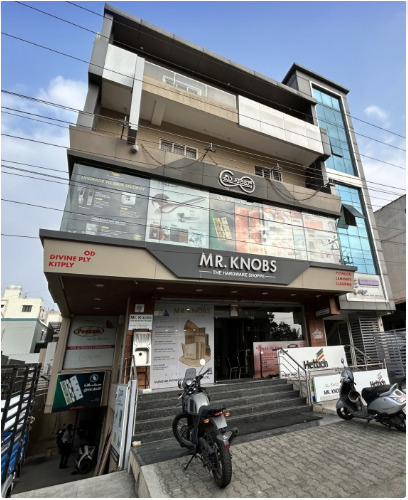
Visit our shop today
Contact Us Today!!!
When it comes to finding the best hardware store in Mysore, Mr. Knobs stands out as the top destination for both professional contractors and DIY enthusiasts. Whether you're undertaking a large-scale renovation or a small home improvement project, our comprehensive selection of high-quality tools and supplies ensures that you'll find everything you need under one roof.
Your One-Stop Shop for Hardware Supplies in Mysore
At Mr. Knobs, we pride ourselves on being the premier hardware shop in Mysore. From construction materials to plumbing supplies, our extensive inventory covers every aspect of your project needs. We stock a wide variety of hand tools, power tools, paint supplies, and building materials, making us the go-to hardware shop near you. Our competitive prices and unparalleled customer service make every visit to our store a rewarding experience.
Comprehensive Range of Hand Tools
Whether you're a professional carpenter, an electrician, or a DIY enthusiast, the quality of your hand tools can make or break your project. At Mr. Knobs, we offer a wide range of hand tools from top brands, ensuring durability and reliability. Our selection includes hammers, screwdrivers, wrenches, pliers, and measuring tools that cater to every specific need.
Each of these tools is made from high-grade materials to withstand the rigors of daily use. Additionally, our expert staff is always on hand to help you choose the right tools for your job, ensuring you complete your projects with precision.
Power Tools for Every Project
When it comes to power tools, Mr. Knobs offers the best in class. Our collection features everything from drills and grinders to saws and routers. We stock power tools from renowned brands known for their innovation and longevity. Whether you're working on woodworking, metalworking, or general construction tasks, our power tools ensure that you get the job done efficiently.
Our knowledgeable staff is here to guide you in selecting the right power tools, providing expert advice to match your specific project requirements. With our commitment to quality, you can be confident that our tools will enhance your productivity and deliver professional results.
Extensive Plumbing and Electrical Supplies
No project is complete without the right plumbing and electrical supplies. At Mr. Knobs, we offer an extensive range of plumbing fixtures, pipes, fittings, and wiring that meet both residential and commercial needs. Our plumbing supplies are sourced from top manufacturers, ensuring they meet industry standards for quality and reliability.
Our electrical department is equally impressive, offering everything from circuit breakers, switches, and cables to lighting fixtures and electrical tools. We cater to both professional electricians and homeowners looking to upgrade their wiring or install new electrical systems.
Paint and Finishing Supplies
A fresh coat of paint can completely transform any space, and at Mr. Knobs, we carry a full range of paint supplies to help you achieve the perfect finish. From interior and exterior paints to primers, sealants, and varnishes, we offer products in various finishes and colors to match your design vision.
We also provide all the necessary accessories, including brushes, rollers, drop cloths, and painter's tape, making sure you have everything you need to complete your painting project. Our paint experts are available to offer tips on color selection, paint types, and application techniques to ensure professional-grade results.
Building Materials for Every Construction Need
For those involved in larger construction projects, Mr. Knobs offers a wide selection of building materials to meet all your requirements. From cement, bricks, and sand to steel rods, tiles, and wood, we are your reliable partner for high-quality construction materials.
Our materials are sourced from the most reputable suppliers, ensuring that they meet the highest standards for strength and durability. Whether you're building a new home, remodeling an existing structure, or working on a commercial project, our building materials will ensure that your foundation is solid.
Gardening and Outdoor Tools
In addition to our comprehensive indoor hardware supplies, Mr. Knobs is also your destination for gardening and outdoor tools. From shovels, rakes, and hoses to lawnmowers, trimmers, and pruners, we provide everything you need to maintain your garden or outdoor space.
Our range of gardening tools is designed to make outdoor maintenance easier and more efficient. With top-quality products from leading brands, you'll find the perfect tools to keep your garden in pristine condition year-round.
Safety Equipment and Accessories
At Mr. Knobs, we understand the importance of safety on every job site. That’s why we offer a wide range of safety equipment, including helmets, gloves, goggles, and protective clothing. Our safety gear is designed to keep you protected while working on any project, ensuring that you can focus on the task at hand with peace of mind.
We also stock a variety of tool accessories, such as drill bits, blades, and fasteners, so you can complete your projects efficiently and effectively.
Why Mr. Knobs is the Best Hardware Store in Mysore
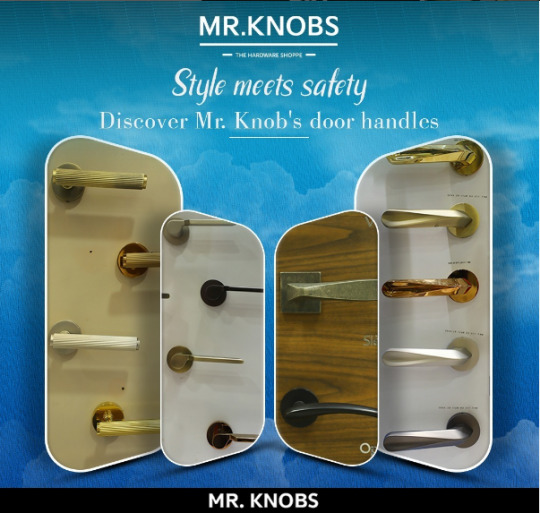
VISIT US TODAY
Unparalleled Customer Service
At Mr. Knobs, customer satisfaction is our top priority. Our knowledgeable and friendly staff are always ready to assist you with any questions you have, ensuring you find the right tools and supplies for your needs. Whether you’re a first-time DIYer or a seasoned professional, our team provides personalized service to make your shopping experience seamless.
Competitive Pricing
We understand the importance of staying within budget for any project. That’s why we offer competitive pricing on all our products without compromising on quality. Our regular promotions and discounts make it even easier to get the best value for your money.
Convenient Location and Accessibility
Located in the heart of Mysore, Mr. Knobs is easily accessible from anywhere in the city. Whether you're searching for a hardware store in mysore or need to pick up supplies on your way to a job site, our store is conveniently located and stocked with everything you need.
Commitment to Quality
Every product we stock at Mr. Knobs is carefully selected for its quality and reliability. We only partner with the most reputable manufacturers to ensure that our customers receive products that stand the test of time. This commitment to quality has made us the trusted choice for hardware supplies in Mysore.
Visit Mr. Knobs Today
For all your hardware needs in Mysore, visit Mr. Knobs, the leading hardware store in the city. Whether you're undertaking a major construction project or simply need to fix a leaky faucet, we have the tools, materials, and expertise to help you get the job done right. Visit us today to experience the best hardware shopping experience in Mysore.
0 notes
Text
Embedded Computing Marled is Anticipated to Witness High Growth Owing to Wide Adoption Across End-use Industries

Embedded computing refers to a computer system that is part of a larger mechanical or electrical system designed to perform a dedicated function. Embedded systems are designed for specific control functions within embedded products and machines and operate under the direct control of an embedded program. Some key features of embedded systems include rugged construction, low power usage, real-time operating capabilities and compact size. Embedded devices are commonly found in industrial equipment, automobiles, consumer electronics, home appliances and medical devices to control electronic systems. Their key advantage is the ability to control electronic processes in a precise, flexible and cost-effective manner.
The global embedded computing market is estimated to be valued at US$ 112.45 Bn in 2024 and is expected to reach US$ 174.38 Bn by 2031, exhibiting a compound annual growth rate (CAGR) of 6.5% from 2024 to 2031.
Wide adoption across industries such as industrial automation, transportation, healthcare, telecommunication and consumer electronics is fueling market growth. Embedded systems allow streamlining of electronic processes, reducing downtimes and operation costs for end-use industries. Key Takeaways Key players operating in the embedded computing market are Advanced Micro Devices (AMD), Inc., Advantech Co., Ltd., Avalue Technology Inc., Curtiss-Wright Corporation, Dell Technologies Inc., Emerson Electric Co., Fujitsu Limited, General Electric Company, Hewlett Packard Enterprise Company, Honeywell International Inc., Intel Corporation, Kontron ST AG, Mitsubishi Electric Corporation, Rockwell Automation, Inc., and Texas Instruments Incorporated. The Embedded Computing Market Demand offers significant opportunities for system integrators and solution providers through new product development and capability expansion. Growing digitization trends across industry verticals will continue to generate strong demand for embedded systems with advanced computing and connectivity features. Leading embedded computing companies are focusing on global expansion strategies through partnerships, joint ventures and acquisitions to solidify their presence in emerging economies of Asia Pacific, Latin America, Middle East and Africa. These regions offer high growth potential driven by ongoing modernization of infrastructure and growing electronics manufacturing activities. Market Drivers Wide adoption across industrial automation applications is a key driver for the embedded computing market. Use of embedded systems allows streamlining of electronic processes, reducing downtimes and operation costs for industrial equipment manufacturers. Growing connectivity trends through Industrial Internet of Things (IIoT) will further propel demand. Rising electronics content in automobiles is positively impacting the market. Advanced driver assistance systems, infotainment systems and vehicle networking require powerful embedded computing solutions. Strict fuel efficiency and vehicle emissions norms will accelerate integration of embedded computing hardware. Market Restrain Design complexity of developing embedded system on a chip (SoC) poses challenges, especially for integrating advanced Embedded Computing Companies capabilities with low power requirements. This increases new product development timelines and costs. Limited standardization across various embedded system platforms inhibits seamless interoperability, data exchange and application portability. This poses difficulties for globally distributed product development activities.
Segment Analysis Automotive industrial and transportation is dominating the embedded computing market due to increasing implementation of advanced driver-assistance systems, connected vehicles solutions, electric vehicles, and autonomous vehicles. According to recent surveys over 65% of all new light vehicles shipped will have features like adaptive cruise control, automatic emergency braking, and blind spot monitoring by 2030. All these emerging technologies are driving the growth of embedded systems in automotive applications. Security and defense is another major sub segment in the embedded computing market owing to rising implementation of thermal weapon sights, combat management systems, imaging payloads and guidance systems in warships, aircraft carriers and fighter jets. Real-time information, enhanced situational awareness and integrated mission capabilities are some key priorities for embedded systems in defense applications. Various nations are also focusing on developing autonomous weapons which will further augment demand in coming years. Global Analysis North America dominates the global embedded computing market with a share of over 35% due to substantial research funding and presence of major OEMs in the region. US and Canada are hub for embedded technology development owing to advancement in networking infrastructure, IoT penetration and adoption of Industry 4.0 concepts. Asia Pacific shows fastest growth momentum led by China, India, Japan and South Korea. Low manufacturing cost and government initiatives to digitize industries are driving Asia Pacific market. Intensifying Sino-US trade war may impact supply chain dynamics in long run. Europe captures around 25% market share led by Germany, United Kingdom and France.
Get more insights on Embedded Computing Market
About Author:
Money Singh is a seasoned content writer with over four years of experience in the market research sector. Her expertise spans various industries, including food and beverages, biotechnology, chemical and materials, defense and aerospace, consumer goods, etc. (https://www.linkedin.com/in/money-singh-590844163)
#Coherent market insights#Embedded Computing Market#Embedded Computing#Microcontrollers#IoT#Firmware#Real-Time Operating Systems#Hardware Design#Software Development#Sensor Integration#Embedded Software
1 note
·
View note
Text
I published an article: 60 common problems in hardware design. Let’s see which ones have you encountered?
Hardware is a very complex system, and problems will be encountered more or less during the design process, so we have compiled 60 common problems. Come and see if you have encountered them? https://www.dhsic.com/news/93
#python#artificial intelligence#software engineering#programming#marketing#machine learning#branding#indiedev#rpg maker#linux#hardware design
0 notes
Text
celebrating fall with fletcher's checksum
This post originally appeared on my website.
why are checksums useful for fpga development?
Checksum functions are useful for error detection and data integrity. With respect to FPGA architecture development, a checksum can ensure the system is able to retain its state. For example, an FPGA programmed to behave like an AND gate should not start to act like an OR gate due fluctuations in voltage or temperature. Such problems may be caught by computing the checksum of the bitstream before configuring the FPGA, operating the device in the lab, and then extracting the bitstream and re-computing the checksum to ensure it has not changed.
The last two FPGAs that I worked on-with Indiana University's SAIL-IN Lab and the QuickLogic Corporation-used a scan chain configuration interface which lent itself well to bitstream verification via checksum. The scan chain acts like a serial shift register, stringing together all the configuration chain flip-flops in the FPGA fabric. As the bitstream flows through the head of the scan chain, one bit at a time, its checksum may be computed; and later re-computed as it flows out of the tail. For context, imagine a small, thirty-two flop scan chain and the corresponding bitstream, 0xdeadbeef. On the way in, the Fletcher's (32-bit) checksum will be 0xf13b. If the post-configuration checksum does not match, the engineers would know that there is an issue with the FPGA architecture.
Fletcher's checksum also produces check bytes (or a "tag"), which can be appended to the end of the original data, such that the new checksum of the data and the check bytes is zero. For the example bitstream 0xdeadbeef, the resulting check bytes are 0xd2f1. And the checksum of 0xdeadbeefd2f1 is 0x0.
fletcher's checksum in systemverilog
Based mostly on the Wikipedia entry for Fletcher's checksum, I produced a parameterized, three-state module which computes the checksum and check bytes of a data stream. The SystemVerilog closesly follows the below psuedo-code. For the Fletcher-32 checksum, data arrives as 16-bit half-words.
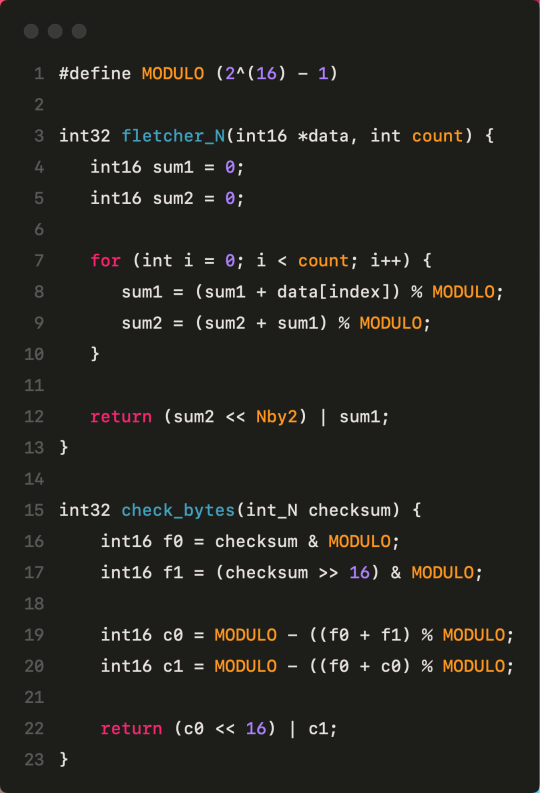
Eventually, I'd like to wrap it in a SPI interface and submit it to TinyTapeout, but for now here's the bare RTL. The most up-to-date code is also available on GitHub:

#engineering#computer engineering#fpga#verilog#systemverilog#hardware design#engineering student#studyblr
0 notes
Text



Interceptor Mega Disk
#@japanretrogame#Interceptor Mega Disk#SEGA Mega Drive#Taiwan Sang Ting Co. Ltd#SEGA#Mega Drive#design#third-party peripheral#manufactured without a license#retro gaming#console gaming#video games#third-party#tech#hardware#ROM dumping#ROM dump#3½ inch floppy disks#SEGA Genesis
1K notes
·
View notes
Text
Console Design- Can I have my cake and eat it too?
Recently I spilled the beans that I have a little hobby project slowly brewing away where I am designing a new game console. I'm still not ready to really properly pitch the whole thing, but between sharing that, explaining computer architecture, and seeing people's feedback, it keeps pushing itself towards the front burners over more practical projects I SHOULD be giving my focus to, and while people are paying attention, I might as well try to crowdsource answers to some questions I'm getting hung up on.
So... a lot of what I'm doing here is, I'll be honest, rooted in nostalgia for 16-bit consoles. There's a certain retro appeal to the look, speed, and general immediacy of 8-bit games, and more than plenty of support for making games that evoke that feel, and even recently made free dev tools for people to just make new games for older systems, and as I'm writing this, there is this massive renaissance going on with indie devs restricting them to the constraints of early polygonal-graphics-focused consoles, but we mostly skipped right past that 16-bit period, and all its hallmarks:
youtube
2D graphics with more color-depth than people really knew what to do with. All sorts of hardware-level flashy effects like transparency, resolution changes, neat little raster effects. A soundscape of crunchy FM synth and sparingly used sampling with distortion effects. Just a little taste of support for polygonal graphics. Not enough to go all-in, but enough to make a nice spice here and there. A general push to show off with fancy jointed paper doll sprites, 3D effects from sprite-scaling, just... clear ambitions all over to make low res 2D eye candy. Plus everything was cartridge based, allowing people to add extra custom chips for things they really wanted that they didn't quite have the power for.
youtube
So that's basically what I want to deliver here. A platform where you have more toys and tricks than you know what to do with if you're coming from 8-bit style stuff, but a real tricky set of restrictions to work around from a more modern approach, hopefully with its own look and sound. To that end I've been doing a ton of research into how some of those work... and a lot of it involves fun little tricks between scanlines. In particular, if you look at that mode 7 video above, right around 7:50, we've got this real eye-popping barrel distortion background. What's going on here, on a hardware level, is we have the ability to, essentially, apply one single image as a texture to a single parallelogram, which in this case is just taking a rectangular background and squishing it in towards the center then out towards its regular dimensions... but where doing that squishing and stretching between individual scan lines as we send the video out to the screen. Several changes to the shape before we've even finished rendering out one frame of the video, and tada, weird barrel.
Being able to support tricks like THAT, specifically, is a must-have feature for what I'm working on, and I'm pretty confident I can design the hardware with that exact capability... but the original hardware doing that was, to my understanding, very much working with the peculiarities of how a CRT worked and the exact number of operations it could get done while the beam was swiping back to the left to draw the next line, and I legitimately have no idea if tricks like this are even really possible if I slap together a similar chipset and send video out an HDMI cord to a modern display.
Like, I know I can fake that. I've got a Retron 5 hooked to a cheap flat panel TV with Castlevania 4 plugged in, but my understanding is that's actually emulating an SNES in software on some very-much-overkill for this sort of thing modern processor. What I would LIKE to do is build this with a chipset you really can push to its limits, hooked to modern display, and get this sort of effect. Because while I realize a big chunk of the audience for this sort of thing totally have nice well-maintained CRTs, I don't want to be married to hardware people no longer manufacture. And I'd rather not have some way more capable sub-processor wedged in here just to get the video output of whatever cheap fast legit 16-bit chipset I use otherwise to play nice with HDMI standards.
I'm still sort of in the dark about HDMI and modern display options, to be clear. And you know in a perfect world I'd like to have support built into this if you want to hook it to a CRT, but at the end of the day I need to pick an aspect ratio, and it's probably gonna be 16:9.
A similar fork in the road I may need to pick a lane for before I can really get going is looking at ASIC chips. What I'd really love is to be able to just point people at a design files for the casing and PCBs, and a warehouse of old mass-produced chips that sell for pennies, make the whole thing a neat little home electronics kit where the total price of everything is like, maybe $10 or $20 or something, you get out a soldering iron, and assemble it all yourself. But, I might need to custom design a chip or two in the end, and there's a chance it ends up being cheaper to just build literally the whole system on one chip. Simpler, easier to make a portable version of the whole thing, but it loses that DIY feel.
And of course there's also the risk that the overall architecture and chipset I'm looking at isn't going to have the oomph to do what I want it to do at a nice steady 60 FPS (maybe 120?) I'm just kind of assuming once I commit to a path I'll be able to find a dirt cheap chipset covering all the bases I need it to that'll hold up at a faster clock speed than consoles really ran at in the mid-90s. I want people to be able to do things smoothly that historically really had some slowdown, and you know, I AM planning to have a higher base resolution than the systems I'm taking inspiration from (maybe the same height but clearly more width).
And of course the real pain is going to be prototyping all this since none of it's going to work without hooking display AND something popped into a cartridge slot. I'm at least saving myself some headache starting with a controller I can at least test in other things, but wow there's gonna be so many different potential failure points to worry about at one step in here.
5 notes
·
View notes
Text
youtube
VHDL Tutorial : Your First VHDL Design: VHDL Entity & Architecture - A Beginner's Guide
Welcome to the ultimate beginner's guide for Your First VHDL Design! In this video, we will dive into the fundamentals of VHDL Entity and Architecture and provide you with a comprehensive understanding of the topic. Whether you are new to VHDL or looking to refresh your knowledge, this guide is designed to help you get started and pave your way to becoming an expert VHDL designer. In this tutorial, we will cover the basics of VHDL, starting with the VHDL Entity and its crucial role in the design process. You will learn how to define and describe the inputs and outputs of your VHDL design using the Entity section, providing the necessary specifications for your project. Moving on, we will explore the VHDL Architecture, which defines the actual implementation of your design. Through a step-by-step walkthrough, you will discover how to construct the architecture block by block, ensuring a well-structured and functional VHDL design. To make the learning experience more practical, we will dive into real-world examples and demonstrate each concept using a popular VHDL software tool. You'll witness the transition from theory to practice, gaining hands-on experience in VHDL design. With this beginner's guide, you'll not only grasp the essentials of VHDL Entity and Architecture but also acquire the ability to kickstart your own VHDL designs, opening up a wide range of possibilities in digital circuit design. Subscribe to our channel for more exciting VHDL tutorials and stay tuned for upcoming videos in this series where we will explore advanced VHDL concepts and applications.
Subscribe to "Learn And Grow Community"
YouTube : https://www.youtube.com/@LearnAndGrowCommunity
LinkedIn Group : https://www.linkedin.com/groups/7478922/
Blog : https://LearnAndGrowCommunity.blogspot.com/
Facebook : https://www.facebook.com/JoinLearnAndGrowCommunity/
Twitter Handle : https://twitter.com/LNG_Community
DailyMotion : https://www.dailymotion.com/LearnAndGrowCommunity
Instagram Handle : https://www.instagram.com/LearnAndGrowCommunity/
Follow #LearnAndGrowCommunity
#VHDL#VHDL Entity#VHDL Architecture#VHDL Design#Beginner's Guide#Digital Circuit Design#VHDL Tutorial#VHDL Basics#VHDL Examples#VHDL Software#Learn VHDL#VHDL Learning#VHDL Step-by-step#VHDL Introduction#VHDL Fundamentals#VHDL Engineering#Hardware Design#Circuit Design#Xilinx ISE#Xilinx Vivado#Digital#ASIC#Engineering#Students#Training#Tutorial#Altera#Hardware description language#modeling style#data flow
1 note
·
View note
Text
Embedded software development company

In today’s digital age, embedded software development has become the backbone of innovation, enabling devices to function seamlessly and efficiently. As industries across the globe undergo rapid transformation, the demand for sophisticated embedded solutions continues to rise. Avench Systems, a leader in embedded software development, is at the forefront of this technological evolution, delivering high-quality solutions that empower businesses to stay ahead of the curve.
Understanding Embedded Software Development
Embedded software refers to specialized programming integrated into hardware devices, enabling them to perform specific tasks. Unlike traditional software, which operates on general-purpose computers, embedded software is designed to run on microcontrollers or microprocessors within devices. It’s an essential component in various applications, from consumer electronics and automotive systems to industrial machinery and healthcare devices.
The complexity of embedded systems requires a deep understanding of both software and hardware. Developing embedded software involves unique challenges, including real-time performance constraints, limited memory and processing power, and the need for reliability and security. Avench Systems excels in navigating these challenges, providing robust and efficient solutions tailored to each client’s unique requirements.
https://avench.com/
Avench Systems: Pioneering Excellence in Embedded Software
Avench Systems has established itself as a premier provider of embedded software development services. With a dedicated team of engineers and developers, the company offers end-to-end solutions that cover everything from concept design and prototyping to software development and testing.

Key Strengths of Avench Systems:
Expertise Across Industries: Avench Systems brings extensive experience across a range of industries, including automotive, consumer electronics, industrial automation, and IoT. This diverse expertise enables the company to develop innovative solutions that address the unique challenges of each sector.
Customized Solutions: Understanding that no two projects are alike, Avench Systems takes a personalized approach to every engagement. The company works closely with clients to understand their specific needs and develop custom solutions that align with their business objectives.
Quality and Reliability: At Avench Systems, quality is paramount. The company adheres to stringent quality standards throughout the development process, ensuring that every solution is reliable, secure, and performs optimally in real-world environments.
Advanced Tools and Technologies: Avench Systems leverages the latest tools and technologies in embedded software development. From advanced microcontrollers and real-time operating systems to sophisticated debugging and testing tools, the company is equipped to tackle even the most complex development challenges.
Collaborative Approach: Collaboration is key to Avench Systems’ success. The company fosters a collaborative environment, working closely with clients, partners, and stakeholders to ensure that every project is delivered on time, within budget, and to the highest standards of excellence.
Innovations Driving the Future
As technology continues to evolve, Avench Systems is committed to staying at the cutting edge of innovation. The company is actively exploring new areas of embedded software development, such as artificial intelligence, machine learning, and advanced data analytics. By integrating these technologies into embedded systems, Avench Systems is helping clients create smarter, more connected devices that deliver enhanced functionality and user experiences.
In addition, Avench Systems is focusing on the growing demand for IoT solutions. The company is developing embedded software that enables seamless connectivity and communication between devices, paving the way for more efficient and automated systems in smart homes, industrial settings, and beyond.
Conclusion
Embedded software development is a critical component of modern technology, driving innovation and enabling new possibilities across a wide range of industries. Avench Systems, with its expertise, commitment to quality, and forward-thinking approach, is a trusted partner for businesses seeking to harness the power of embedded systems.
As industries continue to evolve and the demand for sophisticated embedded solutions grows, Avench Systems is well-positioned to lead the way. With a focus on delivering customized, high-quality solutions that meet the unique needs of each client, the company is helping to shape the future of technology, one innovative solution at a time.
0 notes
Text
Discovering the Best Laminate and Veneer Shop in Mysore: Mr. Knobs
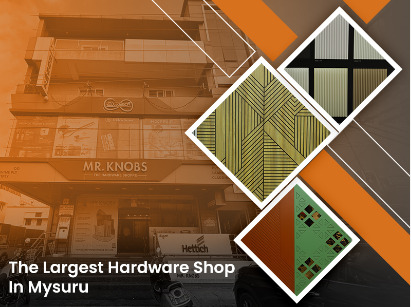
Visit our shop today
Contact Us Today!!!
Introduction
When it comes to interior design, the right materials can make all the difference. In Mysore, a city known for its rich cultural heritage and vibrant modern lifestyle, homeowners and designers alike seek out high-quality laminates and veneers to create beautiful, lasting interiors. This quest often leads them to one name that stands out above the rest: Mr. Knobs. But why is Mr. Knobs considered the best laminate and veneer shop in Mysore? Let's delve into the details.
About Mr. Knobs
Mr. Knobs has been a staple in the Mysore home improvement scene for over a decade. Founded with a mission to provide top-tier decorative materials, Mr. Knobs has grown into a trusted name for both residential and commercial projects. The store prides itself on its commitment to quality, innovation, and customer satisfaction.
Why Choose Mr. Knobs?
The reputation of Mr. Knobs in Mysore is second to none. Customers rave about their experiences, often highlighting the wide range of products, the helpful staff, and the seamless service. Whether you’re a first-time buyer or a seasoned interior designer, Mr. Knobs makes sure you leave with exactly what you need.
Product Range at Mr. Knobs
At Mr. Knobs, you'll find an impressive array of laminates and veneers. Their laminate collection includes everything from high-gloss finishes to rustic wood looks, ensuring there's something for every taste and style. Veneers, on the other hand, range from classic walnut to exotic teak, providing endless possibilities for customization.
Quality and Durability
One of the standout features of Mr. Knobs' products is their unmatched quality. Each laminate and veneer is crafted using the finest materials and advanced manufacturing techniques. This ensures that every product not only looks great but also stands the test of time, even in high-traffic areas.
Eco-Friendly Options
In today’s world, sustainability is key. Mr. Knobs recognizes this and offers a range of eco-friendly products. These laminates and veneers are made from responsibly sourced materials and use environmentally friendly manufacturing processes, making them a perfect choice for the eco-conscious consumer.
Customization Services
At Mr. Knobs, customization is king. They offer personalized design options that allow you to choose the exact size, color, and finish of your laminates and veneers. This bespoke service ensures that your interiors reflect your unique style and meet your specific needs.
Competitive Pricing
Despite the premium quality of their products, Mr. Knobs offers competitive pricing. A comparison with other local suppliers reveals that Mr. Knobs provides exceptional value for money. They believe that high-quality design materials should be accessible to everyone, without breaking the bank.
Expert Staff and Customer Service
The staff at Mr. Knobs are not just employees; they are experts in their field. Their deep knowledge of laminates and veneers ensures that customers receive informed advice and guidance. Additionally, the customer service team is always ready to assist, making your shopping experience smooth and enjoyable.
Showroom Experience
Walking into Mr. Knobs’ showroom is an experience in itself. The thoughtfully designed space showcases their extensive product range in a way that inspires creativity. For those unable to visit in person, Mr. Knobs offers a virtual tour of the showroom, bringing their products right to your screen.
Online Presence
Mr. Knobs has embraced the digital age with an impressive online presence. Their website is user-friendly, featuring detailed product descriptions, high-quality images, and an easy-to-navigate online store. Shopping from the comfort of your home has never been easier.
Delivery and Installation Services
Mr. Knobs goes beyond just selling products; they also offer delivery and installation services. Their professional team ensures that your laminates and veneers are delivered safely and installed correctly, taking the hassle out of home improvement projects.
Client Projects and Portfolio
Seeing is believing, and Mr. Knobs' portfolio speaks volumes. Their completed projects range from chic urban apartments to luxurious country homes. Each project is a testament to their craftsmanship and dedication to excellence.
Awards and Recognitions
Mr. Knobs has not gone unnoticed in the industry. They have received numerous awards for their products and services, solidifying their position as a leader in the laminate and veneer market. Media features and positive reviews further highlight their success.
Conclusion
In summary, Mr. Knobs is the go-to destination for anyone in Mysore looking for high-quality laminates and veneers. Their extensive product range, commitment to quality, and exceptional customer service make them a standout choice. Whether you're renovating your home or working on a new project, Mr. Knobs has everything you need to bring your vision to life.
#hardware hacking#hardware development#hardware shop in mysore#hardware design#hardware#welcome home#the owl house#hardware tools
0 notes